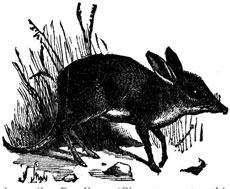|

Who, What, Where, When: Bilbies are marsupial omnivores; they are members of the Peramelemorphia biological order and the largest of the bandicoots. Before European colonization of Australia there were two species. One became extinct in the 1950s, the other survives but remains endangered.
 Just the Facts: Bilbies have the characteristic long bandicoot muzzle and very long ears. As compared with other bandicoots, they have a longer tail, bigger ears, and softer, silky fur. Just the Facts: Bilbies have the characteristic long bandicoot muzzle and very long ears. As compared with other bandicoots, they have a longer tail, bigger ears, and softer, silky fur.
"Sorry, I don't drink..." They are nocturnal omnivores that do not need to drink water, as they get all the moisture they need from their food, which includes insects and their larvae, seeds, spiders, bulbs, fruit, fungi and very small animals.
Most food is found by digging or scratching in the soil, and using their very long tongues.
Master Architects: They are excellent burrowers and build extensive tunnel systems with their strong forelimbs and well-developed claws. A bilby typically makes a number of burrows within its home range, up to about a dozen, and moves between them, using them for shelter both from predators and the heat of the day.

Unusual Marsupial: The embryos of bandicoots, unlike other marsupials, form a placenta-like organ that connects it to the uterine wall. The function of this organ is probably to transfer nutrients from the mother; however the structure is small compared to those of the placentalia.

Classification Confusion: Classification within the Peramelemorphia used to be simple: there were thought to be two families in the order — the short-legged and mostly herbivorous bandicoots, and the longer-legged, more nearly carnivorous bilbies. In recent years, however, it has become clear that the situation is more complex. First, the bandicoots of the New Guinean and far-northern Australian rainforests were deemed distinct from all other bandicoots, and these were grouped together in the separate family Peroryctidae. More recently, the bandicoot families were reunited in Peramelidae, with the New Guinean species split into four genera in two subfamilies, Peroryctinae and Echymiperinae, while the "true bandicoots" occupy the subfamily Peramelinae. The only exception is the extinct Pig-footed Bandicoot, which has been given its own family, Chaeropodidae.

All text is available under the terms
of the GNU Free Documentation License
|